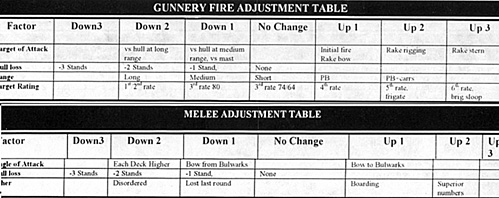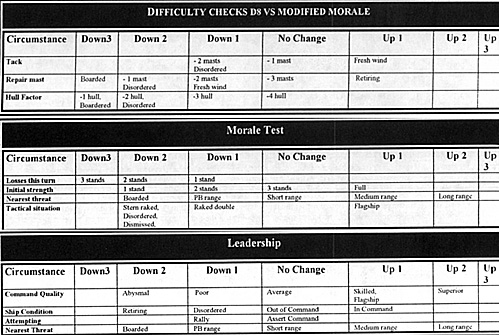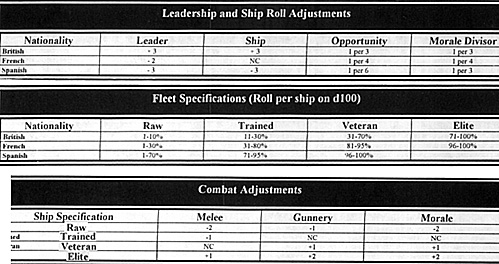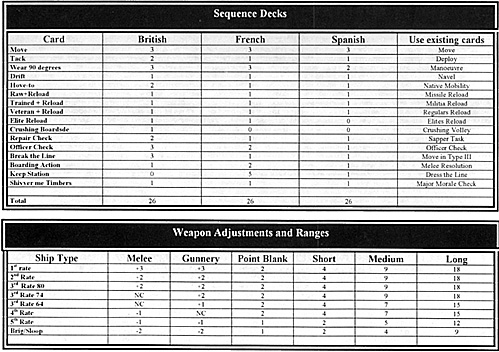These rules have been developed to allow fleet actions, involving between 12 and 30 ships in a single gaming session, rather than ship to ship actions. Therefore detail has been deemed to be less important that 'feel'. Detail such as critical hits including fire tests and rudder damage could be added as a critical hit table which could be consulted whenever a defender D6 is tripled by the firers throw. Please fell free to rise, abuse and modif y these rules as you feel. Indeed these rules may provide a framework from which other naval periods could be developed.
These rules do not include examples of play and some knowledge of naval matters will help in understand some of the mechanisms. There are many good books, both factual and fiction, on the subject which will help new players getting started in this period. Some titles are:
- Warfare in the Age of Sail (the evolution of fighting tactics 1650 to 1830) published by
Conway.
Nelson's Navy by Conway
Any books by Alexander Kent or the Hornblower series by C.S Forester are good ripping yarns.
These rules were played using Hallmark 1/2400 model ships available from:
- Hallmark Figures
Thornville Main Street
Stillington York Y06 ILF
United Kingdom
Tel Number - 01347810147
The prices for these little fellows are for a 74 gun ship for instance costs 95 pence whilst a 17 ship French Fleet can be had for £ 16.20.
1. FORMATIONS
Each ship is a unit. Each ship has 7 stands of 3 hits each. 4 are Hull Stands, and 3 are Mast Stands Units form commands (squadrons) of one or more ships. Commands should be deployed in one of the following formations.
Line of Battle Astern: Ships are placed one behind the other in base to base contact. Where squadrons (commands) form a continuous line astern they move as one command.
Line of Battle Abreast: Ships are placed side by side with a ship 1" interval between them. Providing ships are within one inch of another the formation may adopt any shape.
Ships, which are not in either of the above formations, are OUT OF COMMAND. unless theN are in Line of Battle Astern and have obliqued out of line, but are within 1" of the formation.
There are no DEPLOYMENT cards in the pack. Formations may only be changed by movement and manoeuvre.
2. MOVEMENT
THE WIND. THE MOVE CARD, IMPETUS AND THE IMPETUS CLOCK.
Because sailing ships are powered by the external force of the wind the ' N arc usually in constant motion. To simulate this, all ships, which are not at anchor- dismasted, struck or hove-to, must move whenever a MOVE CARD is turned, the players with the initiative has the option to move before or after his opponent.
The player without die initiative must move each ship (exceptions above) between 1/3 and 1/2 of each ship's maximm move distance on its current course. Turns of 45 degrees may only be executed if the players has an unused MANEOUVRE CARD showing. Ships may hove-to if the player has an unused HOVE-TO CARD showing. Ships may tack if the player has all unused TACK CARD. All ships may oblique as normal.
For each impetus pip used, one is deducted from the "initiative remaining clock". If this takes more pips than those remaining on the clock, the clock is wound back into the next "phase". (Le. If there are 3 points remaining and the player needs 4 points to move the clock will show 19 points remaining at the end of the players movement.
The player with the initiative deducts impetus pips for moving his ships as per a normal game of Piquet, except that because all his ships must use pips from the "impetus remaining clock" once lie has exhausted his "player's impetus" as per the player without the initiative. (Remember that the player with the initiative will have very restricted movement options for those ships moving on the "initiative remaining" clock.)
3. MOVEMENT RATES
Maximum movement rates are dependent oil two factors. The angle of the wind in relation to the ship's orientation. The number of the ship's intact mast "stands".
3.1 ORIENTATION TO THE WIND
Ships may not move towards the wind at angles less than 45 degrees.
Ships are beating if they are sailing towards the wind at angles between 45 degrees and 90 degrees. A beating ships maximum speed is 3".
Ships are running if they are sailing Mill the wind at angles less than 22 degrees. A running ship's maximum speed is 6",
Ships are quartering if they are sailing with the wind to their flank between the running and beating angles. A quartering Ships Maximum speed is 9".
3.2 LOST MAST STANDS
For each mast section lost a ships ship's speed is reduced by one third. Lost mast sections may be recovered with a REPAIR CARD,
3.3 MOVEMENT MANEOUVRE
Ships may wear (turn) 45 degrees and move forward half distance at Oic cost of one inipetus point. If in line astern ilic ships will turn at the point that the lead ship turns.
3.4 OBLIQUE MOVEMENT
Ships may oblique tip to 1" with the following restrictions. Ships that oblique whilst quartering or beating must oblique downwind. Ships, which are tacking, may not oblique.
3.5 TACKING
Ships may allempt to tack through the wind on a TACK CARD and take and pass a tacking difficulty check. Each test costs one impetus pip per command with each ship casting separate pips. Ships failing may try again on the same card.
3.6 HOVE-TO
Strips may come to a slop and remain in the same position on a H0VE-TO CARD. Ships remain hove to until the next hove to or movement card is played. This costs 1 impetus point per ship.
3.7 SAILING IN LINE ASTERN
A formation that is sailing in line astern may find that it has ships sailing with the wind blowing from different aspects. In this case the formation must sail at the speed of the slower ships in order to maintain formation.
4. COMBAT
5.1 GUNNERY
Before firing the player must state whether the target is the opponents rigging or hull. Optional players may wish to reflect French and Spanish tactical doctrine by only allowing their strips to target the hull at short or PB ranges or if they throw a 4,5,6 on a d6.
5.2 MELEE RESULTS
If the defenders win and cause a stand loss the attackers are repulsed and the defender has the option to follow up. If the result is also 3 times greater the attackers are disorganised.
If the defender wins and there is no stand loss the boarders are repulsed.
If the attackers win and the defender loses a stand the defenders are disorganised. If the result is also 2 times greater, the defender strikes.
If the attackers win but cause no stand loss the defenders may not moxe away from the attacker as the ships remain grappled together.
If the result is a draw, the attacker has the option to immediately re-fight the boarding action with a down 1 to their dice. (the defender's dice is not affected).
5.2 DIFFICULTY CHECKS
5.3 MORALE TESTS
Hits on ship:
- 1-2 D4
3-5 D6
6-8 D8
9+ D12
If the testing ship fails it becomes disordered.
If the testing ship fails and its score is doubled the ship must retire to recover morale.
If the testing ship fails and its score is tripled, the ship strikes.
5.4 LEADERSHIP
Command die (d20) as adjusted vs d8
5.5 LEADERSHIP AND SHIP ROLL ADJUSTMENTS
5.6 FLEET SPECIFICATIONS
5.7 COMBAT ADJUSTMENTS
6. SEQUENCE DECKS
6.1 CARD DEFININITIONS
BREAK THE LINE: Ships may pass throngh a line of Battle Astern if they pass a straight morale vs morale test against the ship they are in contact with and then turn up to 90 degrees (no tacking allowed).
Ships in contact with the "passer" may check to see if they follow. Deduct 1 dice for each tester, Failure indicates a collision. Either side may elect to fight a boarding action without a BOARDING CARD (Flight stewardesses beware) with the defender having the option first. If both sides refuses the action the ship in contact turns 90 degrees with no tacking allowed.
WEAR A ship or formation may wheel 90 degrees providing that the bow of the ship does not pass through the wind.
DRIFT All dismasted ships are turned bow into the wind. Drifting ships move 1" per move at a cost of 1 pip per ship.
7. WEAPON ADJUSTMENT and RANGES
8. MELEE ADJUSTMENT
LARGE CREW +1 (Usually French Ships)
Charts




Back to MWAN #106 Table of Contents
Back to MWAN List of Issues
Back to MagWeb Magazine List
© Copyright 2000 Hal Thinglum
This article appears in MagWeb (Magazine Web) on the Internet World Wide Web.
Other military history articles and gaming articles are available at http://www.magweb.com